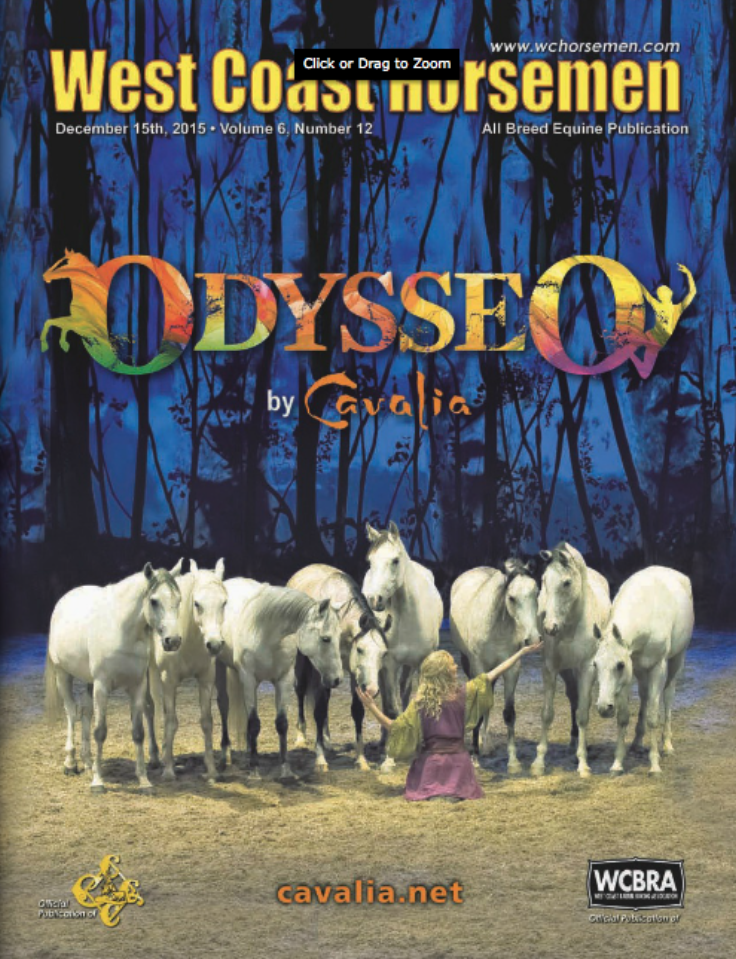WCH – What Are YOU Carrying? As published in the February 2016 edition of West Coast Horsemen Magazine
I’m not a fan of the late winter / early spring season. The novelty of winter has has faded like the snow into a melted mess of dirty grey. Those inside tasks that I’ve saved for the cold season have either already been completed or will most likely stay unfinished. Leather tack has all been cleaned and oiled but that new shelf for saddle blankets is still a random pile of wood waiting to be assembled. It’ll wait a bit longer. In place of half heartedly working on projects, I instead brush the beasts and my spirits are buoyed by the loose hair that my curry raises. Soon we’ll be riding again and venturing out on the trips we excitedly planned during the the first heavy snows of the year. But what to do in the interim before I brush my horses prematurely bald?
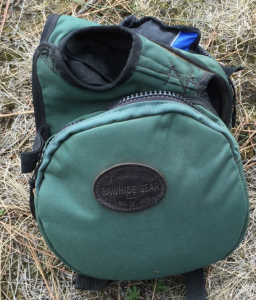 Enter the “Possibles Bag”. I generally call my assortment of “stuff” for an unplanned night on the trail my “Emergency Kit” but the term “Possibles Bag” has much more flair and panache. The term has been around for a while. I heard the word recently when talking about the new Leonard DiCaprio movie The Revenant. It’s a good movie about legendary mountain man Hugh Glass and his “adventures” after having had all of his equipment taken and being left for dead in the wilderness by his friends. The story made me think about both my choices in riding partners as well as the small of collection of items that may well save my life should a trail ride take an unforeseen turn.
Enter the “Possibles Bag”. I generally call my assortment of “stuff” for an unplanned night on the trail my “Emergency Kit” but the term “Possibles Bag” has much more flair and panache. The term has been around for a while. I heard the word recently when talking about the new Leonard DiCaprio movie The Revenant. It’s a good movie about legendary mountain man Hugh Glass and his “adventures” after having had all of his equipment taken and being left for dead in the wilderness by his friends. The story made me think about both my choices in riding partners as well as the small of collection of items that may well save my life should a trail ride take an unforeseen turn.
If and when I’m forced to spend a night along the trail, I want to have nearby all the essentials required to stay alive. For me nearby means either on my person, in pockets or on my belt, or in my pommel bags. Without having a tremendous amount of storage space available, and not wanting to over burden my riding animal with extra weight the trick becomes one of packing only what you need and not a bit more. How much gear “insurance” to carry is a matter of healthy debate and varies from person to person. For me the point of these items is to proactively answer two questions: First; can I respond positively to an accident or emergency? Second, can I safely spend a night out? As you’ll see the contents of my “Possibles Bag” are much different than the black powder, flint and steel, carried by the mountain men of old. What follows is the gear that accompanies me on every ride.
Common Sense – You can’t put it in a bag or carry in in your packet but it’s arguably more important than anything else. Having the right gear is one thing, knowing how and when to use it is another. Experience, know-how, and good judgement is what will save your bacon not a pile of stuff that you purchased and never took the time to earn how to use. Take the time and make the effort to cultivate the knowledge to use every item to its fullest potential.
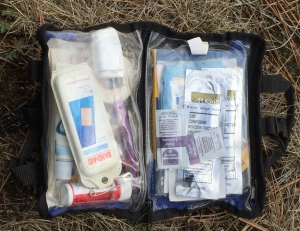 First Aid System – A small first aid kit will come in handy for the minor injuries that we often encounter when riding. Cuts and scrapes are no match for a well balanced and practical collection of supplies. From treating a burn from an errant campfire ember to the nick of a sharp knife a first aid kit is a welcome friend. Of course without the knowledge to use these items you’ll be in a world of confusion. First Aid and CPR courses are readily available. Take one.
First Aid System – A small first aid kit will come in handy for the minor injuries that we often encounter when riding. Cuts and scrapes are no match for a well balanced and practical collection of supplies. From treating a burn from an errant campfire ember to the nick of a sharp knife a first aid kit is a welcome friend. Of course without the knowledge to use these items you’ll be in a world of confusion. First Aid and CPR courses are readily available. Take one.
What I Carry – Adventure Medical Kits, Trail model first aid kit. From bandages to antibiotic ointment this kit has most of what you’ll need, including an excellent book “A comprehensive Guide to Wilderness & Travel Medicine” to help you in an emergency. I’ve augmented mine with extra band aids, super glue, and OTC painkillers. A bigger kit comes along when packing into the back country for extended periods.
 Navigation System – Carry a map of the area you’re riding and know how to find your location based on the landmarks and trail junctions that are marked on it. Even if you’re “just going on a day ride” practice your map reading skills. Learn how to use a compass. A compass will help you find north and orient your map which is often all you need to find your way if you get misplaced. Traditional map and compasses are nearly foolproof and don’t rely on batteries. Carry a GPS and cell phone if you want but remember their limitations.
Navigation System – Carry a map of the area you’re riding and know how to find your location based on the landmarks and trail junctions that are marked on it. Even if you’re “just going on a day ride” practice your map reading skills. Learn how to use a compass. A compass will help you find north and orient your map which is often all you need to find your way if you get misplaced. Traditional map and compasses are nearly foolproof and don’t rely on batteries. Carry a GPS and cell phone if you want but remember their limitations.
What I Carry – Brunton Type 15 Compass with signal mirror and built in sighting line. It’s not cheap but neither does it cut any corners.
 Insulation System – Weather happens. It gets chilly at night on the trail while waiting for the sun to rise. A scarf will not only protect your neck from a sunburn it’ll also help keep you warm in the cooler evening hours. It’s rare to find me without a rain slicker, even when riding the high desert. Not only will a slicker keep you dry it can provide a welcome extra layer of insulation to keep you warm.
Insulation System – Weather happens. It gets chilly at night on the trail while waiting for the sun to rise. A scarf will not only protect your neck from a sunburn it’ll also help keep you warm in the cooler evening hours. It’s rare to find me without a rain slicker, even when riding the high desert. Not only will a slicker keep you dry it can provide a welcome extra layer of insulation to keep you warm.
 What I Carry – Shemaghs (pronounced schmogs) have hundreds of uses from sun protection to emergency slings. For sheer functionality these cotton scarfs are unbeatable. To keep me dry in the saddle I rely on a traditional rain slicker from Outfitters Pack Station. Nothing fancy here, just a lightweight waterproof coat that works as intended.
What I Carry – Shemaghs (pronounced schmogs) have hundreds of uses from sun protection to emergency slings. For sheer functionality these cotton scarfs are unbeatable. To keep me dry in the saddle I rely on a traditional rain slicker from Outfitters Pack Station. Nothing fancy here, just a lightweight waterproof coat that works as intended.
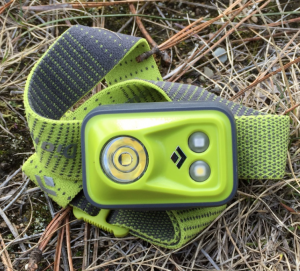 Illumination System – It can get dark out there! Having a reliable light source will come in handy should you have to spend the night on the trail as well as when you’re making dinner back at camp. LED headlamps are rapidly becoming the go-to light source because they allow hands free operation, are small and have a long battery life.
Illumination System – It can get dark out there! Having a reliable light source will come in handy should you have to spend the night on the trail as well as when you’re making dinner back at camp. LED headlamps are rapidly becoming the go-to light source because they allow hands free operation, are small and have a long battery life.
What I Carry – Black Diamond Cosmo. With 3 high output LEDs and weighing a feather light 3 ounces this headlamp puts out a blindingly bright beam that can last for up to 250 hours.
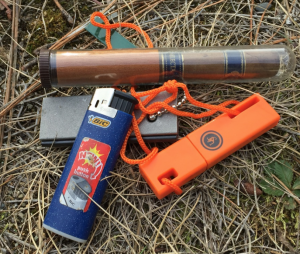 Fire System – From warmth to signaling, to the cheering effects a cozy campfire, if you’re spending an unexpected night out having the option to make a fire is a wonderful feeling.
Fire System – From warmth to signaling, to the cheering effects a cozy campfire, if you’re spending an unexpected night out having the option to make a fire is a wonderful feeling.
What I Carry – Small and cheap are the hallmarks of the bic lighter, fire steel, and stub end of a candle that have permanent homes in the bottom of my pommel bags. With these three tools I can, and have, made camp fires in a variety of conditions.
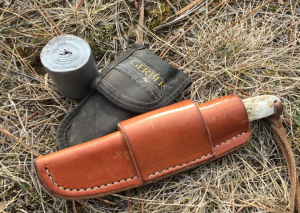 Repair Kit System – A Gerber multi tool, a bit a duct tape and some imagination are all you really need to patch up equipment and tack that fails on the trail. If it cannot be mended with a knife, pliers, and some duct tape all is lost.
Repair Kit System – A Gerber multi tool, a bit a duct tape and some imagination are all you really need to patch up equipment and tack that fails on the trail. If it cannot be mended with a knife, pliers, and some duct tape all is lost.
What I Carry – A Gerber multi tool, a fixed blade knife, and a small roll of duct tape.
 Nutrition System – Riding is exercise and you’ll want to refuel throughout the day. An extra bit of food in case the day suddenly becomes longer is always a good idea.
Nutrition System – Riding is exercise and you’ll want to refuel throughout the day. An extra bit of food in case the day suddenly becomes longer is always a good idea.
What I Carry – A handful of Snickers bars. It’s not exactly healthy but we all have our vices.
Hydration System – Without water your body’s systems won’t be able to perform well. Drinking too little H2O will not only make you thirsty, it will also make you more susceptible to hypothermia and other maladies. When you go for a ride remember to take water with you and to drink it freely.
What I Carry – My water bottle of choice is a wide mouthed stainless steel bottle from Klean Kanteen. Not only can it hold almost a liter of water, it’s nearly indestructible and I can even boil water in it if needed.
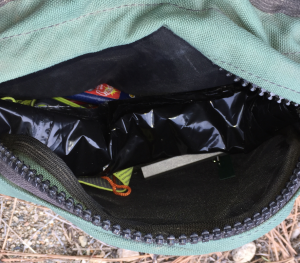 Shelter System – If you’re suddenly forced to spend an unplanned night out of doors you’ll want some type of shelter from the rain and the wind. Combined with your insulation system your shelter will make a long night a little less miserable.
Shelter System – If you’re suddenly forced to spend an unplanned night out of doors you’ll want some type of shelter from the rain and the wind. Combined with your insulation system your shelter will make a long night a little less miserable.
What I Carry – A contractor’s garbage bag is wonderfully handy not only for helping clean up a trailhead but also as emergency bivy sack that will keep a person sheltered. I’ve found that rolling the bag tightly and tying with twine keeps bulk to a minimum. The baling twine has been useful more than once to repair tack while on the trail.
Don’t leave home without some version of these basic items. Being prepared for eventualities on the trail will pay dividends and maybe even save your life. What will you have in your Possibles Bag?
As always until next month enjoy the trails. For the nation’s largest database of great places to ride and camp with your mules please visit www.TrailMeister.com .


